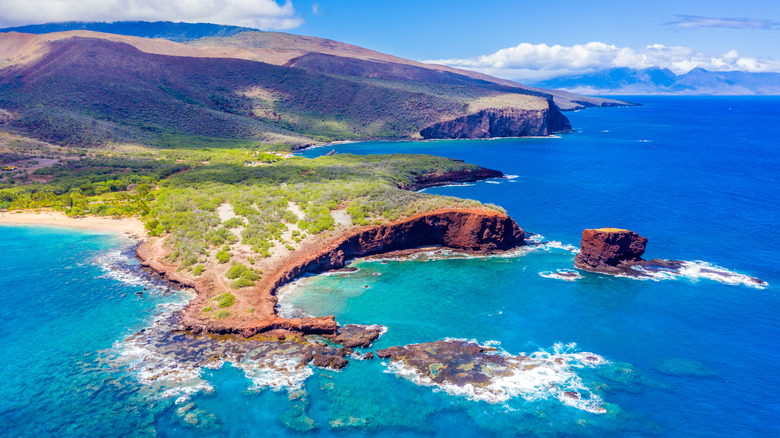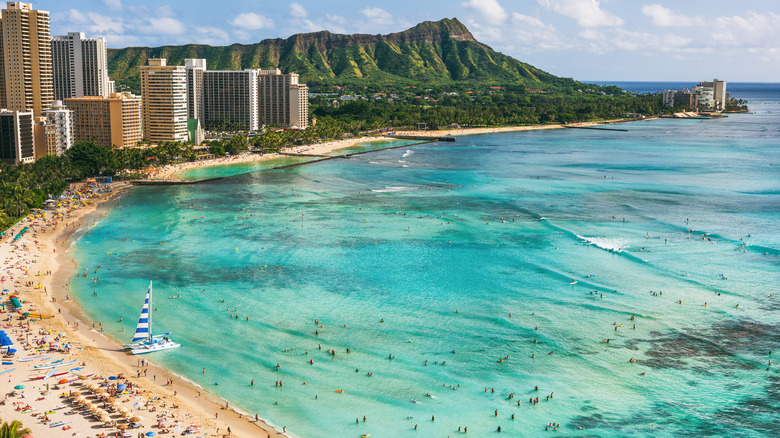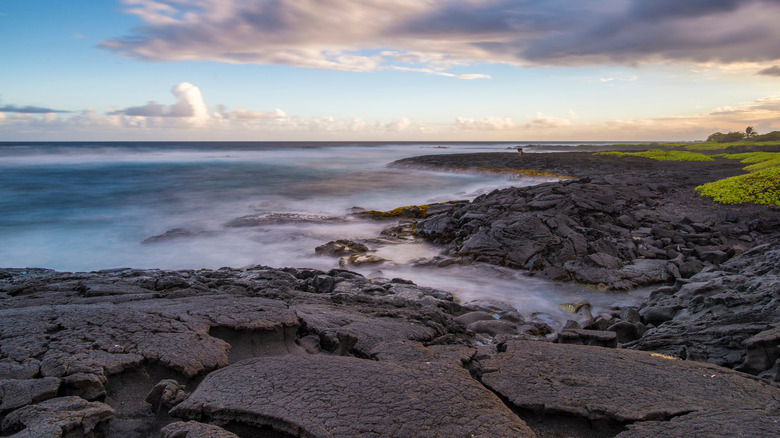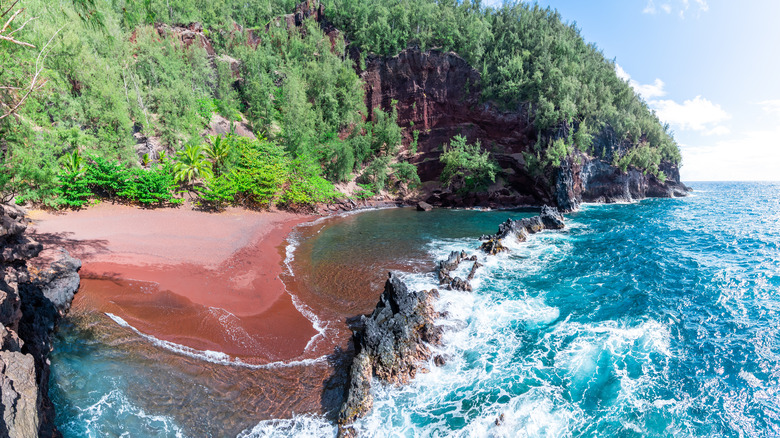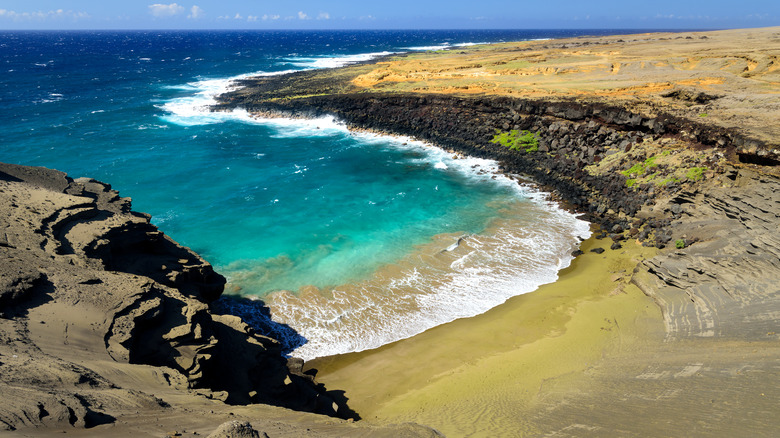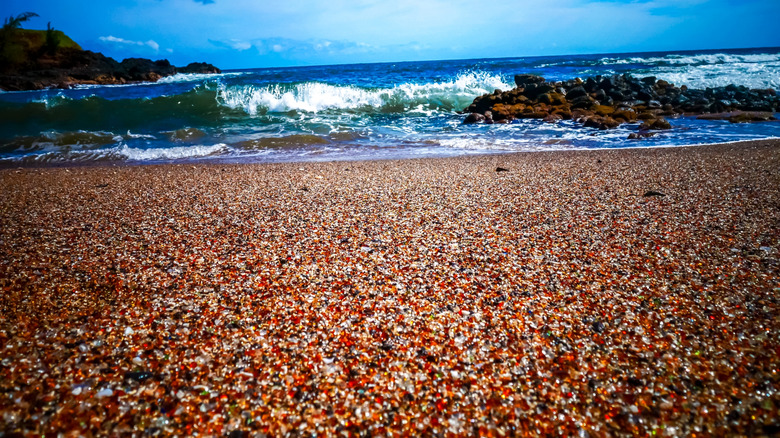Many Beaches In Hawaii Hold A Colorful Secret
Sand is more than simply small stones carved down by the ocean waves. Most tourists flock to the picturesque white sand beaches offering Instagram-worthy content, but Hawaiian beaches have so much more to offer, with sand colors ranging from classic white to black, red, green, and even multi-colored glass.
While it is true that sand is formed by the erosion of the constant ebb and flow of the ocean waves, tides, and the elements; sand is actually a combination of rocks, minerals, and contributions from aquatic creatures (via National Ocean Service). The sand you see on many beaches comes from rocks already on land that are weathered by the elements, which can hint at the geology of the area. But it also comes from bits and pieces of aquatic animals, like their shells, skeletons, and other hard marine pieces. In places with coral reefs, parts of the reef can break off and end up on shore (via Woods Hole Oceanographic Institution). Beaches tell a rich story of their surrounding environment –– what stories can the beaches of Hawaii tell us?
White sand: Waikiki Beach
Waikiki beach is probably one of the most well-known beaches in Hawaii. It's located on the island of Oahu near Honolulu and stretches for two miles across eight sections (via Best of Oahu). The most fascinating part of this beach — and all of the white sand beaches in Hawaii — is that it's not your typical white sand. Most white sand beaches get their color from quartz crystals inside rocks that have been eroded over time. Quartz is the second-most common mineral found on Earth's surface, so there's no wonder why it ends up on many white sand beaches worldwide (via Boss Frog).
However, due to the geology of the Hawaiian islands, there is not quartz anywhere nearby. So where does Hawaii's white sand come from? Well, it's a collection of fish poop and skeletons. Hawaiian white sand is mostly calcium carbonate from skeletons of coral that are broken down by either waves or eaten by parrotfish, which is then digested, pooped out, and floats down to the ocean floor. The parrotfish break off bits of coral to eat the algae on its surface, creating hundreds of pounds of white sand every year (via National Ocean Service).
Black sand: Punaluʻu Beach
Punaluʻu Black Sand Beach is located on the southeastern shore of the big island, with Hawaii Volcanoes National Park nearby. The beach is remote, but the long trek holds a steep reward. The black sand on this beach was formed by lava from volcanoes, the same way the Hawaiian islands were created. When the red hot lava hits the ocean water, it quickly cools and hardens, turning into basalt lava rock. The process shatters the rocks into tiny pieces, which over time get broken down even further by the ocean waves, creating an otherworldly black sand beach (via Boss Frog).
This breathtaking beach is home to many large sea turtles, two of which are endangered species: the green sea turtle and hawksbill turtle (via Big Island Guide). The Hawaiian name "Punaluʻu" means "spring diver for," which is a nod to its history when locals would go diving to collect the underground spring water flowing up into the bay. Because of this, you may find some freshwater tide pools in the area to explore.
Red sand: Kaihalulu Beach
If you've never seen a red sand beach before, visiting Kaihalulu Beach (near Hana on Maui) is definitely a bucket list item. This rare, red sand is formed by — you guessed it — volcanoes. However, the reason this sand ends up red instead of black is due to the high iron content in the lava rock. The red color also indicates that the hot lava didn't make it all the way to the shore before cooling down, unlike black sand that automatically cools and hardens from hitting the ocean waves.
This lava slowed and cooled before reaching the beach; the additional air exposure coupled with the high iron content in the rock created iron oxide, the same chemical compound that makes rust (via Boss Frog). Kaihalulu Beach even has the remnants of a volcanic cinder cone right along the shore, making this one of the most unique and jaw-dropping beaches in the world (via Hawaii Magazine).
Green sand: Papakolea Beach
There are only four green sand beaches worldwide and Papakōlea Beach on the big island of Hawaii is one of them. Located in Mahana Bay near the southernmost point in the United States, this beach is surrounded by Puu Mahana, a cinder cone created over 49,000 years ago from a volcanic eruption (via Big Island Guide). The green sand of Papakōlea Beach comes from olivine — a common mineral found in magma — from inside the cinder cone. As the cone slowly erodes from the ocean waves and elements, the olivine in the rocks are exposed and eventually turned into sand.
Olivine is heavier than volcanic ash, which explains why there is so much of it left behind on the beach, as other lighter materials get washed away from the shoreline, leaving the beach a majestic green hue (via Boss Frog). For now, fresh olivine continues to coat this beach as erosion does its job, but over time it will all get swept away to sea and the beach will lose its iconic green color — visit now while you still have the chance.
Glass Sand Beach
This unique beach is not 100% natural. Located on the southern side of the island of Kauai, this beach used to be a trash site, becoming the final resting place for many different glass bottles, windows, auto parts, and other types of discarded junk (via Only In Your State). Over time, the reliable waves of the ocean did what they do best and eroded the trash into tiny glass pieces, eventually creating a sea glass beach. It can take the ocean waves anywhere from 10 to 30 years to form a piece of sea glass.
Kauai's Glass Beach contains millions of multi-colored glass sand pebbles ranging from aquamarine to green to frosty white and brown. Sadly, in recent years, tourists have reported that the shore feels more like a basic beach than a glass sand beach, due to many visitors taking handfuls of sand home as a souvenir. Needless to say, this beach is still worth visiting, and if you do: only take pictures.
